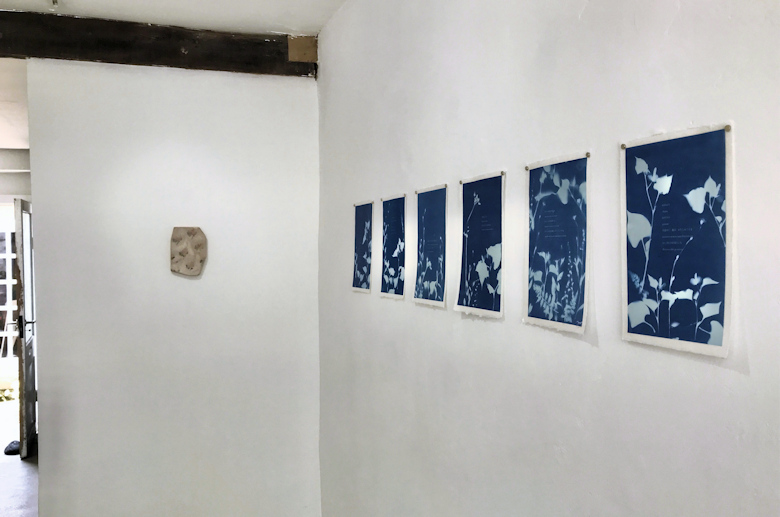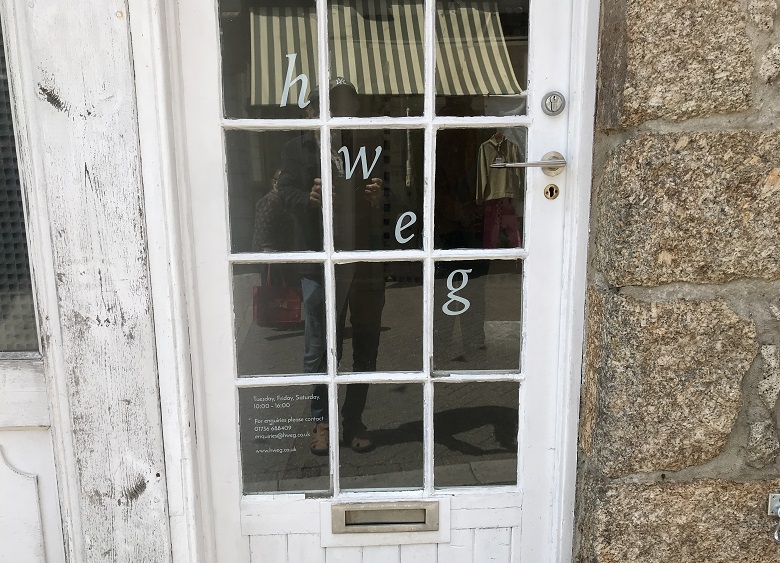|
Reasons to be cheerful: Two exhibitions at Hweg, Penzance
Martin Holman
The progress of Hweg is the best story to come out of the west Cornwall
art scene in the past year. This small venue has quickly established
itself as a place for good encounters with interesting artists. One
reason is that Joe Lyward, whose gallery it is, applies sensitivity to
his selection of work to show and people to work with. A bold
intelligence informs how he presents that work: for a location of its
size, Lyward packs a lot in. That does not mean an overabundance of
individual items; usually it is the opposite. Instead each piece
deserves attention in a hang that includes the luxury of spaciousness.
So artworks have the chance to speak for themselves - seldom loudly,
which is an integral part of the experience - and visitors the
opportunity for thought. The invitation to look, consider and remember
is powerful and rewarding.
The two most recent exhibitions exemplify
these attractive qualities. The first, ‘In Flower Beds’, involved nine
artists from at least three continents who have the presence of mind to
locate their activity in the quietest, most productive and restorative
corner of nature, the garden. As well as images, text was a factor in
the show: one of the works was an essay, another a poem and a third a
bookmark. ‘A Painter’s Garden’, specially commissioned from Dutch
painter Anke Roder and printed in the show’s exquisite publication,
provides a delicate and well-phrased accompaniment to the subtle
interweaving of colour, line and space across the walls. Both the words
and the booklet reflected the tone of profundity in simplicity that
characterised the show.
Mana Yamamoto was represented by the suite of cyanotypes reframing
branch and leaf forms that set lines of poetry in Japanese against a
background of evening blue (pictured below).
Together, these prints measured only a fraction of the area covered by
Ben Sanderson’s garden-like multiple plantings in a double-sided collage
drape: fabrics, processes and media coalesced into the visual event he
calls 08/07/2022, the title assuming the temporal record of making and
completion. Between these two extremes of size was a delicate
watercolour plant study on handmade paper by Jatinder Singh Durhallay. A
framed C-type photograph, the camera lens delves into a cluster of
grassland flowers which fill the image area until the point of focus is
passed. The composition approaches the tactility of being nose deep into
the fragrant spikiness and sensual rapture of growing things.

The collaboration between scale, surface, image and idea once again
benefited from the space the works were given on the walls, both within
the room and against the light filtering through front front window and
back door. By its very being, Sanderson’s piece was free-hanging,
partitioning the space into impromptu front and back areas. On first
meeting it inside the doorway no distraction on the wall detracted from
the gentle beauty of its tones and the robust, concentric, sewn linear
elements that fold the visitor’s attention into its introverted core.
The one piece in its sightline at the doorway was so small that it felt
like a migrant on its untroubled journey to settle in Sanderson’s refuge
of an hortus conclusus. This was a woodcut print on thin paper,
the dimensions of a bookmark (its most likely original purpose in the
world) by an unknown maker. Lyward saw it, liked it and bought it in
Japan. The miniature object (because Lyward’s choice has made it so)
somehow imported the far-eastern spirit of great aesthetic significance
in the smallest peaceful intention that this gallerist so admired during
his time in that country. It also bracketed the show with humility,
being quiety visible on arrival and more apparent on leaving, once mind
and eye had been aligned with Lyward’s well-honed sensibility.
A subtle distinction between the works, in a show of subtleties, was the
disparity between being overtly made and occupying an imaginative
dimension so that the piece felt as if it had wandered into the category
of art from another existence altogether. Sanderson’s hanging shows off
its making with barely suppressed eagerness through processes of dyeing,
cutting, stitching, printing and edging. And although the most
art-historically grounded item here, Winifred Nicholson’s painting
'Two Nosegays' (c.
1945-51) assumed no primacy amongst its younger and living
co-exhibitors. It hung in the back part of the gallery and, behind the
Sanderson work swaying lethargically in a draft, probably relished being
on equal terms with the others. The canvas depicts two jugs on a sill,
each filled with the small bunches in its title set against a vague,
hazy far horizon in a landscape gently modelled in light. The drawing,
paintwork and contrived composition spoke of artistic construction.
But not so Robyn Graham’s 'Holding'
(like everything except Nicholson’s painting,
made post-pandemic in 2022-23). An unevenly shaped object with a
decorated surface standing out from the wall on a base of pronounced
depth, it looks as if it has come fully-formed from another use. The
front plane has a floral design which is not easy to make out
(pictured above). Visible spots of green acquire context in this
company as leaves, to which patches of washed-out red make sense as
flower heads. But any form they might have had appears dissolved into
the surface by time, sunlight or some other force to break through now
only like blushes on a flushed complexion.
One fascinating feature of this work is the call it makes on the viewer
who wants to account for its appearance. Inferring a history in its
elusive coloration and unusual shape is natural, enjoyable and only ever
speculative. Was this remnant once wallpaper from a demolished house,
its walls knocked violently apart by a wrecking ball? Do only portable
shards remain of an interior once called home, where a pattern of
flowers brought the consolation of nature into an urban sitting room?
And even that is on the precipice of disappearance - yet it holds its
presence: it is not done yet. ‘Perhaps the appearance of flowers in a
home,’ writes Lyward in his foreword, ‘printed on fabrics, is to put us
in flower beds, to nurture and heal us while we rest.’

The second exhibition continues until 19 August and comprises ceramics
by Elena Gileva who works in London but grew up and first attended art
school in Russia. Around the walls and flat surfaces are objects on a
domestic scale that suit the interior of Hweg. Gileva calls the show
‘Vocabulary of tactile language’ and she is true to her title. The work
has a homespun feel about it by association with its visible making
directed towards function or decoration, or both, and from which Gileva
has extracted its formal clarity to take on an entirely aesthetic
dimension. There are cultural and, conceivably, historical journeys,
latent for an English audience to conjecture in her use of weaving and
basic ceramic forms. Those forms are mostly built up from clay rolled in
a manoeuvre of making that has been part of ceramic’s history for
thousands of years and emerged independently as an intuitive method in
different parts of the globe. These rolls are conventionally a prelude
to coiling the still pliable material and adding layers to construct the
walls of vessels in an efficient process that does not need slip for the
object to cohere into a firm structure before firing.
Gileva builds tall vessel forms in this way, although not in this show
since the earthenware pillars and sugar mountain-like obelisks that
result are above waist-high to the viewer and beyond the scope of what
she wants to achieve here. Yet she carries many of their characteristics
over into these smaller objects, such as their organic silhouettes
implying handling and shaping; their bright colouring, applied as slips
and glazes; and the socialising of different shapes into active
combinations or tableaux. One of these is the small-scale ‘landscape’ of
clay objects set out on the counter top just inside the gallery door.
The basic material is rolled or somehow extruded, and then folded or
looped, bent or creased. One roll steps over another, like a worm
crossing an obstacle by arching itself over. Others have coiled up like
sea creatures in defensive mode, biding their time before unfurling and
moving on, while another has curled tensely upwards on its back as if
exercising its ligaments. Some resemble a length of plasticine, still
ridged and monochrome as if from the wrapper; one polygonal stretch of
clay is creased along its length in a manner that resembles piping. So
identities are pleasingly masked, as with the circles of braided ropes
of ceramic that glisten like enlarged microbial organisms, primitive
life forms or something unsettlingly intestinal.
That is one arrangement. On the walls more shapes intermingle at
different heights between floor level and just about overhead, as if
gravitating towards each other at a networking event from which one or
two might stand back shyly. The materials mix, too, between lattices of
clay rolls to patches of woven threads that boast the coarse edges the
ceramics cannot aspire to. Here and there tablets with modulated, glazed
finishes infiltrate the community of weaved elements, appearing more
solid with their brazen displays of extended area. Slabs appear and also
twisted aspects, some plaited and others dropped like a splat that is
then glazed and fired. Some are matt, others glossy, and the colours are
celebratory oranges, gold, purples, greens, blues and yellows. Do they
have meaning? Has the viewer walked into a party or, maybe, a festival
that the absent makers (there are enough variations to suggest multiple
minds if we wanted to prolong the fantasy and the wondering) always mark
this way to respect their culture or beliefs? We feel welcome.
Hweg is not seeking comparisons with other galleries in Penzance or the
wider area of West Penwith. Lyward’s intention is to provide a calm
space for art that invites a careful encounter. He is achieving the
promise of the gallery’s name, the equivalent in English for this
Cornish adjective being ‘kind’, ‘pleasing’, ‘gentle’, in the positive
sense of a mutually arrived-at encounter that fosters well-being.
Nonetheless, and in pursuit of that aim, Hweg’s value exceeds its modest
footing and should give much larger, longer established and even
publicly financed venues pause for searching reflection.
‘In Flower Beds’ took place between in June
2023 and ‘Elena Gileva: Vocabulary of tactile language’ runs from 15
July to 19 August 2023, both at Hweg, 34 Causewayhead, Penzance TR18 2SP.
Also see interview with Joe Lyward in 'interviews'.
© Martin Holman 2023 |


